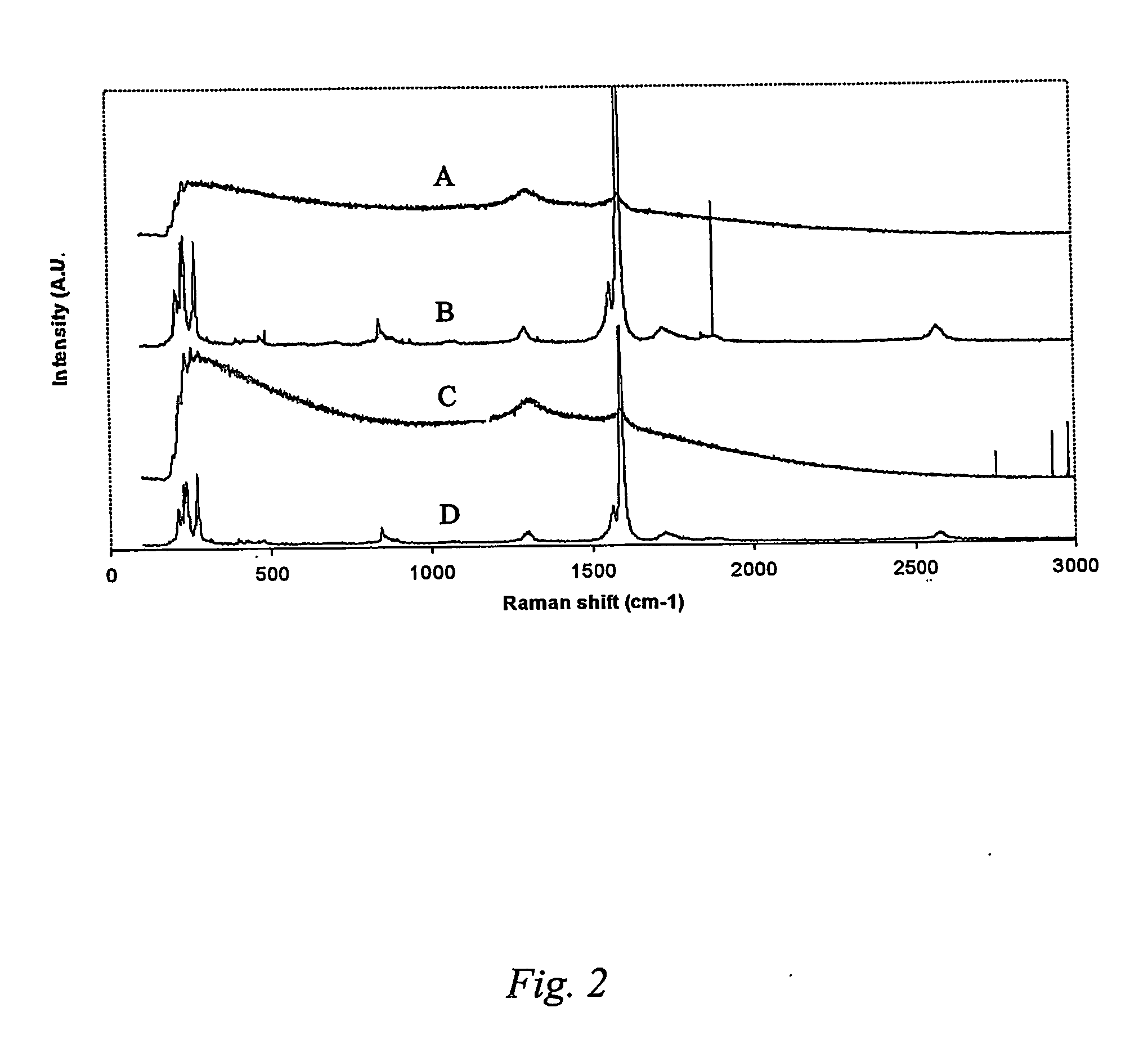Functionalized carbon nanotube-polymer composites and interactions with radiation
a technology of functionalized carbon nanotubes and composite materials, applied in the field of materials, can solve the problems of unsuitability of final products of chemically modified or functionalized carbon nanotubes, and achieve the effect of crosslinking
- Summary
- Abstract
- Description
- Claims
- Application Information
AI Technical Summary
Benefits of technology
Problems solved by technology
Method used
Image
Examples
example 1
[0047] This Example serves to illustrate embodiments in which medium energy protons can be used to modify the properties of fluorinated CNT-polymer composites and / or blends.
[0048] As long term space-based experiments are not a practical way of accessing the radiation characteristics of materials, SWNT-polymer composites were irradiated with 40 MeV protons at the Texas A&M University Cyclotron Institute (TAMCI). The proton energies and the total particle fluence used in this example are consistent with the radiation environment of low earth orbit (LEO); such as the environment encountered by the International Space Station (ISS). To characterize the effects of proton irradiation on CNTs, the samples were characterized by thermogravimetric analysis (TGA) and Raman spectroscopy.
[0049] The SWNTs used in this example were obtained from Tubes@Rice and Carbon Nanotechnologies, Inc, both in purified form. These nanotubes were produced by the pulsed laser vaporization [Rinzler et al., Appl...
example 2
[0057] This Example serves to illustrate a manner in which a sensor of the present invention comprising functionalized CNTs and a polymer host matrix can be used as a radiation dosimeter.
[0058] The present invention is directed toward radiation sensors (e.g., dosimeters) comprising functionalized CNTs in a polymeric host material. In some embodiments, such a device comprises a dielectric substrate on which a layer of functionalized CNT-polymer composite and / or blend is deposited. Using a power source, a voltage can be applied across this layer. As the device is exposed to radiation that defunctionalizes the functionalized CNTs, there is an increase in current across the layer. With calibration and a thorough understanding of the interactions of particular kinds of radiation with a particular type of functionalized CNT, it is possible to monitor radiation dosages and fluences in real time. The device components are easily miniaturized such that the device can be worn by a person as ...
example 3
[0059] This Example serves to illustrate multi-functional materials of the present invention, comprising functionalized CNTs and a host material, that can be used in time-dependent applications.
[0060] Embodiments directed toward multi-functional materials comprising functionalized CNTs and a host material often rely on changes in said materials as they are exposed to radiation over a period of time—continuously changing the properties of the materials.
[0061] As an example, functionalized CNTs dispersed in motor oil could be engineered to impart gradual changes to the viscosity of such a fluid when exposed to a particular type of radiation. This would permit the tuning of the oil's viscosity in situ, without having to change it. Furthermore, after having altered the oil's viscosity to a sufficient extent, the oil could be used for an entirely different purpose. Additionally, or alternatively, such time-dependent behavior could be made to respond to other environmental input (e.g., ...
PUM
| Property | Measurement | Unit |
|---|---|---|
| weight percent | aaaaa | aaaaa |
| weight percent | aaaaa | aaaaa |
| thickness | aaaaa | aaaaa |
Abstract
Description
Claims
Application Information
 Login to View More
Login to View More - R&D
- Intellectual Property
- Life Sciences
- Materials
- Tech Scout
- Unparalleled Data Quality
- Higher Quality Content
- 60% Fewer Hallucinations
Browse by: Latest US Patents, China's latest patents, Technical Efficacy Thesaurus, Application Domain, Technology Topic, Popular Technical Reports.
© 2025 PatSnap. All rights reserved.Legal|Privacy policy|Modern Slavery Act Transparency Statement|Sitemap|About US| Contact US: help@patsnap.com



